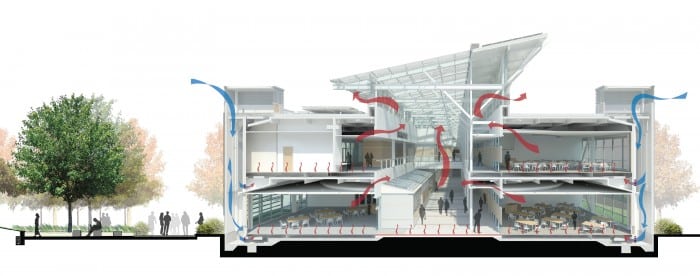
The Mediated Learning Center at DeAnza College in Cupertino, Calif., is an exciting project for those who will occupy it as well as those who are designing and building it. When it’s complete this spring, the $35 million facility – which is targeting LEED Platinum certification by the U.S. Green Building Council – will boast an innovative buoyancy-driven air circulation system that’s unusual even among “green” projects.
Instead of relying on a forced-air system to route air throughout the 66,900-square-foot building, the buoyancy-driven system relies on physical science, forces of nature and the heat generated by building occupants and electronics. It’s designed to ventilate more than 80 percent of the building without fan power and produce indoor air quality by supplying 100 percent outside air through six hourly air changes.
Here’s how it works: The system draws in outside air through tower-shaped intakes on the rooftop. As the air passes over cooling coils and the temperature decreases, it descends through the shafts into the under-floor air chambers serving the first and second floor. Heating coils warm the air as needed to meet occupant-preferred temperature settings and then supplies it through floor-based vents as part of the building’s energy-efficient under-floor air distribution system. As people and equipment warm the air throughout the day, the air and indoor air pollutants rise to ceiling exhaust shafts and move to the atrium. Sandwiched between classrooms and offices, the atrium – topped with a fritted, high-performance glass skylight – releases air to the outdoors through its clerestory louvers.
Not surprisingly, this system’s implementation requires a sophisticated level of coordination and commissioning throughout construction. Sundt and other members of the project team meet regularly to review how the system is being implemented and develop methods to track circulation and measure output.
Helping take green projects to a whole new level…now that’s a breath of fresh air.